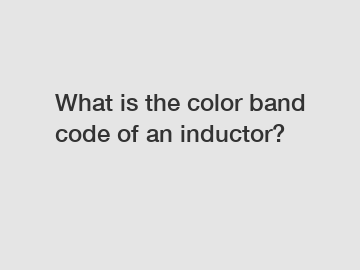The Color Band Code: Decoding the Secrets of Inductor Colors.
When it comes to the world of electronics, there are countless components that may seem mystifying to the uninitiated. And among these enigmatic devices, the inductor stands out as a crucial element in many electronic circuits. Used for energy storage, filtering, and signal processing, understanding the specifications of an inductor is vital for any electrical engineer or hobbyist. One important aspect to decipher the characteristics of an inductor is the color band code, a simple yet powerful tool that holds the key to its secrets.
To the untrained eye, an inductor might appear as nothing more than a simple coiled wire. However, upon closer inspection, one can notice a series of colored bands adorning the body of the component. These bands may seem like arbitrary decorative marks at first, but they hold an immense amount of information about the inductor's properties.

Each color band represents a specific digit or multiplier, akin to the color-coded resistance bands found on resistors. By interpreting the sequence of colors, you can determine the inductor's value, tolerance, and sometimes even its temperature coefficient. This color band code system enables engineers to select the right inductor for their designs and ensure optimal performance.
Let us dive deeper into the world of inductor color band codes and unravel the secrets they possess:
Color Bands and Their Meanings:
The color bands found on inductors follow a specific order, and the values they represent are standardized across the industry. The most common configuration used for color band coding in inductors is a four-band code, denoting the inductor value and tolerance.
Starting from the left side, the first band represents the first significant digit of the inductor value. The second band represents the second significant digit, while the third band signifies the multiplier. Lastly, the fourth band corresponds to the tolerance, which tells us how close the actual value of the inductor lies to the advertised value.
To illustrate this, let's consider an example where the color bands on an inductor are brown, black, orange, and gold. By referring to the standard color code chart, we can decode this configuration to determine the inductor's value. The brown band corresponds to the digit 1, the black band represents the digit 0, and the orange band signifies a multiplier of 1,000. Thus, our example inductor has a value of 10,000 microhenries.
Additionally, the gold band in this example indicates a tolerance of ±5%. This means the actual value of the inductor can range from 9,500 microhenries to 10,500 microhenries, ensuring a sufficient margin for error.
Color Band Code Variations:
While the four-band code is the most prevalent, there are variations that provide additional information about the inductor. For instance, there is a five-band code that includes an additional band for the temperature coefficient. This coefficient denotes how much the inductor's value changes with temperature variations.
Moreover, inductors with low tolerances often have a three-digit code. Here, the third band represents the number of zeros to be added onto the first two significant digits. Using this information, design engineers can easily identify the right inductor for precision applications.
Understanding Color Band Codes:
To familiarize yourself with inductor color band codes, it helps to take advantage of online resources, mobile applications, or simply make use of color-coded charts. These tools aid in quickly identifying the value and properties of an inductor based on its color band configuration.
Remember, practice makes perfect. By studying the color band codes and exposing yourself to more inductors with their respective value indications, you'll become more proficient in decoding their secrets. Soon enough, you'll be able to determine the characteristics of an inductor at a glance.
Conclusion:
Inductors may appear mysterious to those unfamiliar with their inner workings. However, by leveraging the power of color band codes, these components reveal their secrets. The color bands, meticulously placed on the inductor's body, hold valuable information about its value, tolerance, and, in some cases, its temperature coefficient.
Understanding the color band code system empowers every electronic enthusiast and engineer to confidently select the right inductor for their projects. By decoding this seemingly cryptic language, you gain a deeper understanding of an inductor's properties and unlock the potential for optimizing your circuits.
So, the next time you encounter an inductor, take a closer look at its color bands and marvel at the hidden knowledge they possess. The color band code truly offers a doorway into the world of inductors, where creativity, expertise, and human-like understanding converge.
Are you interested in learning more about metal oxide film resistor, glass resistor, carbon film resistors wholesale? Contact us today to secure an expert consultation!



Comments
Please Join Us to post.
0